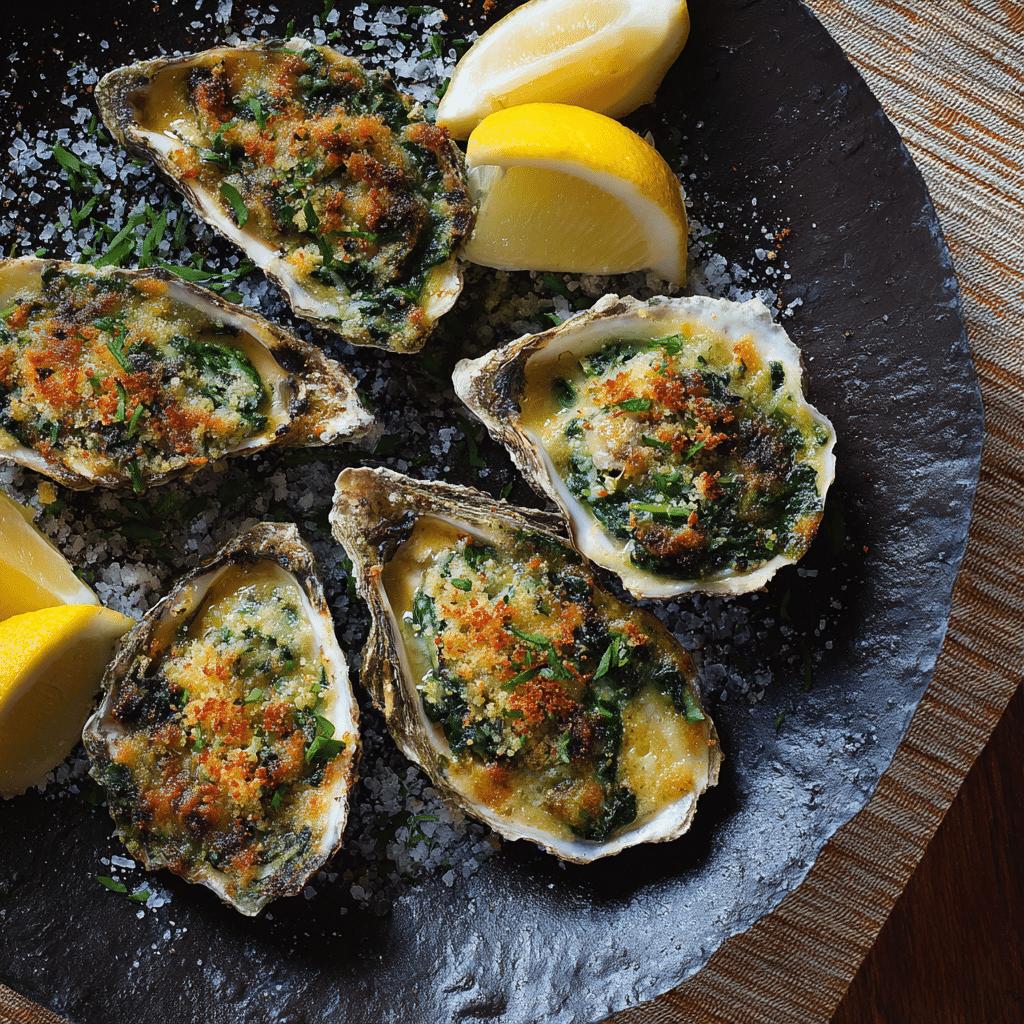The legendary Oysters Rockefeller has stood the test of time for good reason—it’s a dish that balances rich, herbaceous flavor with briny ocean freshness. First created in the late 1800s at Antoine’s in New Orleans, this iconic recipe has since graced tables around the world, from coastal oyster bars to white-tablecloth restaurants.
This version keeps things simple and elegant: fresh oysters on the half shell topped with sautéed spinach, garlic, shallots, and a buttery hint of anise. Finished with a golden-brown topping of Parmesan and panko breadcrumbs, it’s baked until bubbling and irresistible. Whether you’re hosting a holiday feast or simply treating yourself to a gourmet moment at home, Oysters Rockefeller delivers indulgent flavor in every bite.
Full Recipe
Ingredients:
-
12 fresh oysters, shucked and on the half shell
-
2 tablespoons unsalted butter
-
2 cloves garlic, minced
-
1/4 cup shallots, finely chopped
-
1/2 cup fresh spinach, finely chopped
-
2 tablespoons fresh parsley, finely chopped
-
1 tablespoon Pernod or anise-flavored liqueur (optional)
-
1/4 cup grated Parmesan cheese
-
1/4 cup breadcrumbs (preferably panko)
-
Salt and pepper to taste
-
Lemon wedges, for serving
-
Rock salt, for baking
Directions:
-
Preheat your oven to 450°F (230°C). Line a baking sheet with rock salt to stabilize the oysters.
-
In a skillet over medium heat, melt the butter. Add shallots and garlic, and sauté until translucent, about 2 minutes.
-
Add chopped spinach and cook until wilted, about 2 minutes more. Stir in parsley and Pernod, if using. Cook for an additional 1 minute, then remove from heat.
-
Season with salt and pepper.
-
Arrange the oysters on the prepared baking sheet. Spoon the spinach mixture evenly over each oyster.
-
Mix breadcrumbs and Parmesan together in a small bowl and sprinkle over each oyster.
-
Bake for 8–10 minutes, or until the topping is golden and bubbly.
-
Serve hot with lemon wedges on the side.
Prep Time: 15 minutes | Cooking Time: 10 minutes | Total Time: 25 minutes
Kcal: 95 kcal | Servings: 4 (3 oysters per serving)
A Classic Dish with a Rich History
Oysters Rockefeller is a timeless and iconic dish, deeply rooted in American culinary history. First created in 1899 at the famed Antoine’s restaurant in New Orleans, this luxurious oyster preparation was named after John D. Rockefeller, the richest man in America at the time, due to its richness in flavor and ingredients. The original recipe was kept secret, and to this day, the precise composition of Antoine’s original version remains a closely guarded mystery. What we do know is that it was designed to be rich, indulgent, and unforgettable—traits that modern variations have preserved.
This dish has since evolved, with chefs and home cooks alike recreating it in countless ways, often featuring a base of sautéed greens, butter, herbs, and a crispy breadcrumb or cheese topping. Despite the changes, its essential character remains intact: a celebration of fresh oysters, intensified by savory, aromatic toppings and briefly baked to bubbling, golden perfection.
Why Oysters Rockefeller is a Favorite for Entertaining
Oysters Rockefeller is the kind of dish that instantly elevates any dining experience. Its combination of flavors and textures—briny oyster, velvety butter, aromatic herbs, and a golden, crispy top—makes it a crowd-pleaser. But beyond taste, it offers a presentation that’s both elegant and impressive. Served on the half shell and arranged on a bed of rock salt or seaweed, it becomes a visual centerpiece for any gathering.
It’s no surprise this dish is popular at dinner parties, weddings, holiday feasts, and upscale seafood restaurants. Whether served as an appetizer or the star of a light meal, Oysters Rockefeller gives an air of sophistication with relatively little preparation time.
The Role of Ingredients in Flavor Development
Though the ingredient list can vary, certain flavor profiles are nearly always present in a good Oysters Rockefeller. Spinach or other leafy greens offer earthiness and moisture. Garlic and shallots bring pungent, sweet aromatics. Butter delivers the essential richness, tying everything together and soaking into the oyster’s natural juices. Parmesan cheese adds a savory, nutty dimension and aids in browning, while panko breadcrumbs give it that signature crispy topping.
Pernod, or another anise-flavored liqueur, is an optional but traditional addition that offers a subtle herbal complexity that’s unique to this dish. The key is in balancing these elements so that no single one overpowers the delicate oyster beneath.
Best Oysters to Use for Rockefeller
The type of oyster you use will greatly influence the final flavor and texture. East Coast oysters, like Blue Point or Wellfleet, tend to be smaller, brinier, and slightly more mineral-forward—ideal for Oysters Rockefeller, as their robust flavor can stand up to the rich toppings. West Coast oysters, such as Kumamoto or Pacific oysters, are sweeter and creamier, which can also pair well depending on your flavor preferences.
What’s essential is that the oysters are fresh. Ideally, they should be shucked just before cooking to preserve their texture and natural brine. The half shell not only serves as a natural serving dish but also helps retain moisture during baking.
Tips for Perfectly Baked Oysters Rockefeller
Getting the texture right is crucial. The topping should be golden and slightly crisp, but the oyster itself should remain tender—not rubbery or overcooked. A hot oven (usually around 450°F or 230°C) is important to ensure the topping browns quickly, limiting the time the oysters spend in the oven.
One trick is to place the oysters on a bed of rock salt or crumpled foil while baking. This stabilizes the shells, prevents tipping, and allows for even cooking. Additionally, using chilled ingredients in your topping mix can help slow down the cooking of the oyster as the topping heats and browns.
Don’t skimp on presentation—finish the baked oysters with a fresh squeeze of lemon or a sprinkle of chopped parsley just before serving to brighten up the flavors and add a pop of color.
Pairing Suggestions and Serving Ideas
Oysters Rockefeller is best served hot and fresh from the oven. It’s typically enjoyed as a starter, but you can easily transform it into a light main dish with the right accompaniments. A fresh green salad with a citrus vinaigrette or a chilled cucumber soup pairs well and balances the richness of the oysters.
For beverages, dry white wines like Sauvignon Blanc, Muscadet, or Chablis are excellent choices—they cut through the butter and highlight the oceanic flavor of the oysters. Sparkling wines or Champagne are also fabulous options if you’re looking to celebrate or elevate the occasion.
You could also lean into the New Orleans origin and serve it alongside a French 75 cocktail or an absinthe-based drink to match the licorice notes of Pernod, if used in your recipe.
Modern Twists and Variations
While the traditional recipe is a favorite, many cooks have begun experimenting with creative twists. Some add bacon bits or pancetta to the topping for a smoky contrast. Others incorporate cream cheese or Gruyère for extra decadence. Vegetarian versions use mushrooms in place of oysters, preserving the topping’s flavors while adapting the dish for different dietary needs.
If you’re gluten-free, substitute the breadcrumbs with crushed nuts or gluten-free panko. You can also explore dairy-free versions using plant-based butter and cheese, though the flavor will naturally shift.
Regardless of how you personalize it, the beauty of Oysters Rockefeller lies in its flexibility. It’s a dish that invites interpretation without losing its fundamental identity.
Why This Dish Endures Through Time
The enduring popularity of Oysters Rockefeller can be attributed to its perfect blend of indulgence, ease, and elegance. It’s one of those rare dishes that feel gourmet but can be prepared in under half an hour. That balance makes it ideal for both special occasions and casual yet elevated meals at home.
The contrast between textures and flavors—crisp and creamy, salty and herby, warm and fresh—offers a sensory experience that few appetizers can match. It taps into the luxurious feel of fine dining while being entirely achievable for the home cook.
Conclusion
Oysters Rockefeller is more than just an appetizer; it’s a symbol of culinary heritage, refinement, and celebration. Whether you stick to the classic French Creole roots or modernize it with new ingredients, this dish continues to delight and impress. It represents everything great about cooking: the transformation of simple, fresh ingredients into something truly extraordinary.
Perfect for holidays, romantic dinners, or impressing guests at your next gathering, Oysters Rockefeller will never go out of style. It’s a dish that pays homage to tradition while leaving room for innovation—a true gem in the world of seafood cuisine.






